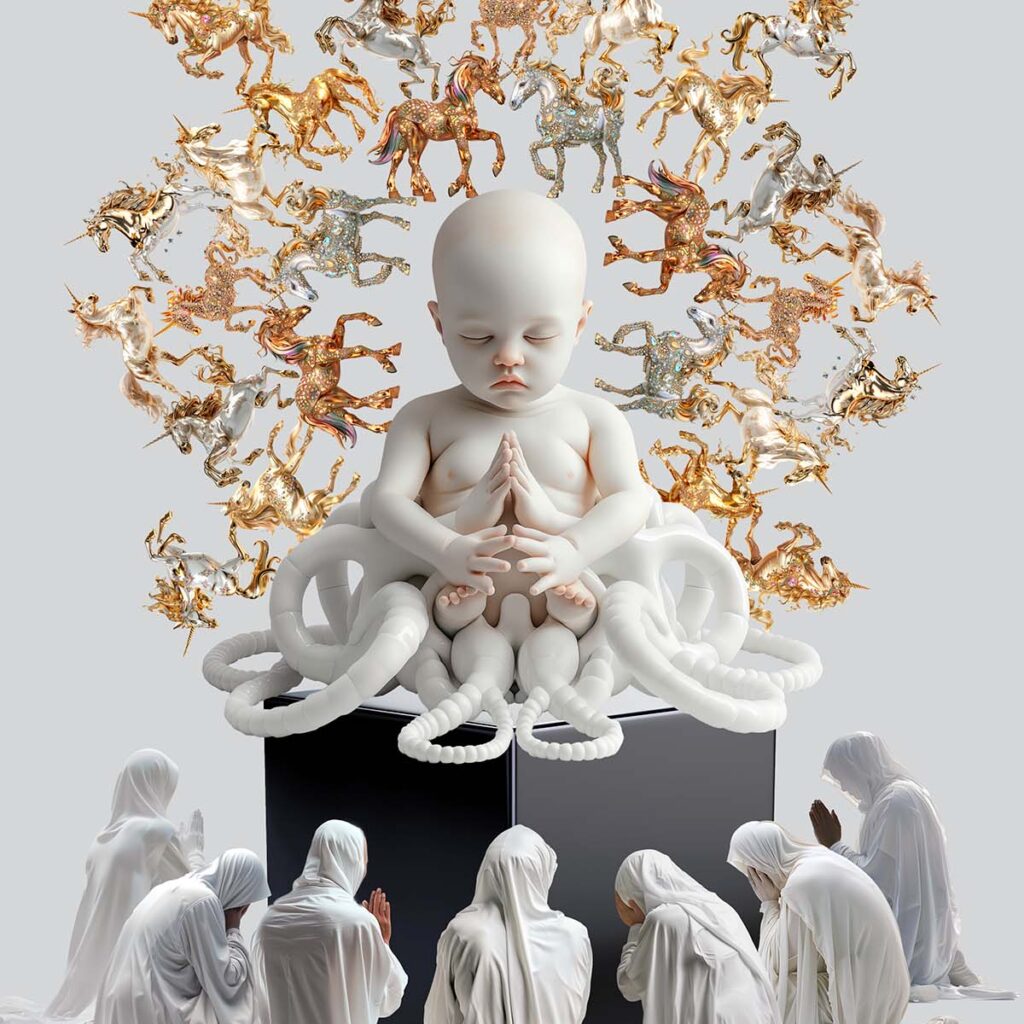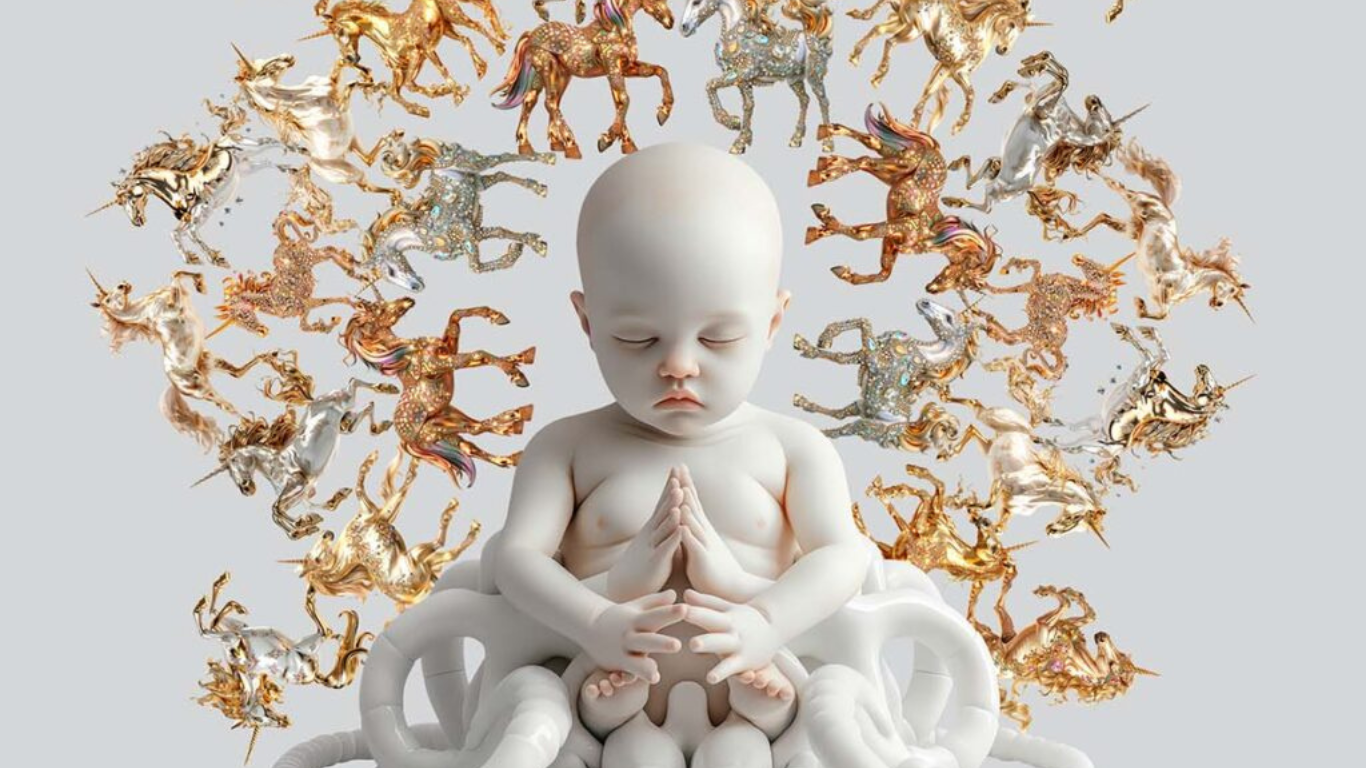
In Arthur C. Clarke’s famous short story “The Nine Billion Names of God,” a sect of monks in Tibet believes humanity has a divinely inspired purpose: inscribing all the various names of God. Once the list was complete, they thought, He would bring the universe to an end. Having worked at it by hand for centuries, the monks employ some modern technology. Two skeptical engineers arrive in the Himalayas, and powerful computers are in tow. Instead of 15,000 years to write out all the permutations of God’s name, the job gets done in three months. As the engineers ride ponies down the mountainside, Clarke’s tale ends with one of literature’s most economical final lines: “Overhead, without any fuss, the stars were going out.”
It is an image of the computer as a shortcut to objectivity or ultimate meaning—which also happens to be, at least part of, what now animates the fascination with artificial intelligence. Though the technologies that underpin AI have existed for some time, it’s only since late 2022, with the emergence of OpenAI’s ChatGPT, that the technology that approached intelligence appeared to be much closer. In a 2023 report by Microsoft Canada, president Chris Barry proclaims that “the era of AI is here, ushering in a transformative wave with potential to touch every facet of our lives,” and that “it is not just a technological advancement; it is a societal shift that is propelling us into a future where innovation takes centre stage.” That is among the more level-headed reactions. Artists and writers are panicking that they will be made obsolete, governments are scrambling to catch up and regulate, and academics are debating furiously.
About the art
The above image, showing what AI is capable of in the hands of an artist, was made by designer Marian Bantjes using Midjourney, a platform that generates images based on text prompts. The composition, made up of twenty images selected from hundreds created over several sessions, depicts AI (symbolized by an otherworldly baby) being worshipped and promising impossible things.
Businesses have been eager to rush aboard the hype train. Some of the world’s largest companies, including Microsoft, Meta, and Alphabet, are throwing their full weight behind AI. On top of the billions spent by big tech, funding for AI start-ups hit nearly $50 billion (US) in 2023. At an event at Stanford University in April, OpenAI CEO Sam Altman said he didn’t really care if the company spent $50 billion a year on AI. Part of his vision is for a kind of super assistant, one that would be a “super-competent colleague that knows absolutely everything about my whole life, every email, every conversation I’ve ever had, but doesn’t feel like an extension.”
But there is also a profound belief that AI represents a threat. Philosopher Nick Bostrom is among the most prominent voices asserting that AI poses an existential risk. As he lays out in his 2014 book Superintelligence: Paths, Dangers, Strategies, if “we build machine brains that surpass human brains in general intelligence . . . the fate of our species would depend on the actions of the machine super-intelligence.” The classic story here is that of an AI system whose only—seemingly inoffensive—goal is making paper clips. According to Bostrom, the system would realize quickly that humans are a barrier to this task, because they might switch off the machine. They might also use up the resources needed for the manufacturing of more paper clips. This is an example of what AI doomers call the “control problem”: the fear that we will lose control of AI because any defences we’ve built into it will be undone by an intelligence that’s millions of steps ahead of us.
Before we do, in fact, cede any more ground to our tech overlords, it’s worth casting one’s mind back to the mid-1990s and the arrival of the World Wide Web. That, too, came with profound assertions of a new utopia, a connected world in which borders, difference, and privation would end. Today, you would be hard pressed to argue that the internet has been some sort of unproblematic good. The fanciful did come true; we can carry the whole world’s knowledge in our pockets. This just had the rather strange effect of driving people a bit mad, fostering discontent and polarization, assisting a renewed surge of the far right, and destabilizing both democracy and truth. It’s not that one should simply resist technology; it can, after all, also have liberating effects. Rather, when big tech comes bearing gifts, you should probably look closely at what’s in the box.
Walrus is located within the bounds of Treaty 13 signed with the Mississaugas of the Credit. This land is also the traditional territory of the Anishnabeg, the Haudenosaunee, and the Wendat peoples.
What we call AI at the moment is predominantly focused on LLMs, or large language models. The models are fed massive sets of data—ChatGPT essentially hoovered up the entire public internet—and trained to find patterns in them. Units of meaning, such as words, parts of words, and characters, become tokens and are assigned numerical values. The models learn how tokens relate to other tokens and, over time, learn something like context: where a word might appear, in what order, and so on.
That doesn’t sound impressive on its own. But when I recently asked ChatGPT to write a story about a sentient cloud who was sad the sun was out, the results were surprisingly human. Not only did the chatbot produce the various components of a children’s fable, it also included an arc in which, eventually, “Nimbus” the cloud found a corner of the sky and made peace with a sunny day. You might not call the story good, but it would certainly entertain my five-year-old nephew.
Robin Zebrowski, professor and chair of cognitive science at Beloit College in Wisconsin, explains the humanity I sensed this way: “The only truly linguistic things we’ve ever encountered are things that have minds. And so when we encounter something that looks like it’s doing language the way we do language, all of our priors get pulled in, and we think, ‘Oh, this is clearly a minded thing.’

